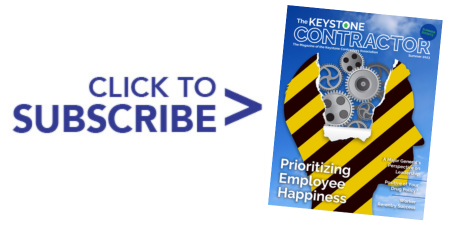Worker safety has become a very hot topic since 2020. The building industry is full of problem solvers, and that has put it in a strong position to handle the challenge of COVID-19.
Worksites have evolved to address the threat of the virus and builders have continued to make progress for the good of their communities.
“We’re still building houses. We’re building roads. We’re building hospitals,” said Carl Heinlein, senior safety consultant for American Contractors Insurance Group.
In the past year, a bigger emphasis has been placed on preplanning, as site managers develop workflows to space out workers. Temperature checks, masks, and stricter sanitation have become the norm for worker safety. With masks, it’s been as much about learning when they are not necessary. For example, wearing one on a 95-degree day when a worker is not near anyone else is unnecessary and could contribute to overheating.
Creative solutions have included the use of QR codes to track the movement of workers on job sites and temperature scanning stations that workers can walk through. If tools are shared, they are cleaned after each use. Sites may have sheds or trailers where tools can be sprayed with disinfectant and left overnight.
Builders have met the challenge, and they can’t let up now that vaccines finally are available.
“We’re not out of the woods yet,” Heinlein said. “We still have to maintain some good practices that we’ve learned.”
Builders also must adapt to new OSHA guidance. In March, the agency launched a national emphasis program focusing on “high-hazard industries” where employees could be at serious risk of contracting the virus, based on their potential close-contact exposures to the public and coworkers.
The industries targeted in the program include building construction; heavy and civil engineering construction; specialty trade contractors; asphalt paving, roofing, and saturated materials manufacturing; and other petroleum and coal products manufacturing. Many of these industries include members of the Keystone Contractors Association.
Builders must be careful not to focus solely on COVID-19, though. It’s important to remain vigilant about traditional worker safety threats as well.
“We still have falls, struck-bys, caught-betweens, electrocutions,” Heinlein said.
Driving to and from the workplace always is a hazard to be aware of as well.
It’s been a long year and people are fatigued, which makes mental health a big concern.
Workers may have additional stresses of their children’s virtual schooling, their spouse’s unemployment or other problems brought on by the pandemic. Firms and local unions are making sure their workers and members know what resources are available if they need assistance.
“Are people focused on the job or are they distracted?” Heinlein said. “We’re still in the people business. We still have that human element.”
Workers also must be encouraged to take the same precautions at home, to protect their loved ones and to keep themselves healthy and in a position to stay on the job.
Safety resources
Keystone Contractors Association
Occupational Safety and Health Administration
National Utility Contractors Association
Associated General Contractors of America






